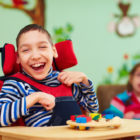
Opinion: Behavioral Challenges Can Push Youth With Disabilities Into School-to-Prison Pipeline
|
Who are youth with intellectual and developmental disabilities (IDD)? The population of youth with IDD is vast. In 2018-19, the number of students ages 3–21 who received special education services under the Individuals with Disabilities Education Act (IDEA) was 7.1 million or 14% of all public school students. You may know some better-known IDDs such as autism spectrum disorder (ASD), fetal alcohol spectrum disorder (FASD), Down syndrome and cerebral palsy, to name a few.
What you may not know is that many youth with IDDs may have behavioral challenges associated with their disability due to communication barriers, which in turn may evolve into behavioral problems such as property destruction, harm to themselves, harm to others or elopement. However, often the student with IDD behavior serves a purpose and is most likely functional.
For example, consider someone with ASD.








